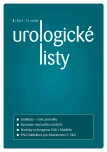Tackling the Percutaneous Nephrolithotomy
Authors:
J. Knoedler; A. Krambeck
Authors‘ workplace:
Department of Urology Mayo Clinic Rochester
Published in:
Urol List 2015; 13(2): 17-21
Overview
Modern-day PCNL is a safe procedure with low morbidity. It offers superior stone-free rates, and is the treatment of choice for larger or staghorn stones. In order to be done successfully and safely, surgeons should be aware of important variations in anatomy, patient comorbidities, and potential complications. Finally, although a variety of techniques exist for PCNL access, stone removal and exit from the kidney, surgeons should be well versed in available techniques and adhere fundamental principles of surgery to achieve the desired outcomes for their patients.
Key Words:
nephrolithotomy, stone, nephrolithiasis, nephrostomy, lithotripsy, urolithiasis
Sources
1. Duvdevani M, Razvi H, Sofer M et al. Third prize: contemporary percutaneous nephrolithotripsy: 1585 procedures in 1338 consecutive patients. J Endourol 2007; 21(8): 824–829.
2. Desai M, Jain P, Ganpule A et al. Developments in technique and technology: the effect on the results of percutaneous nephrolithotomy for staghorn calculi. BJU Int 2009; 104(4): 542–548. doi: 10.1111/j.1464-410X.2009.08472.x.
3. Opondo D, Tefekli A, Esen T et al. Impact of case volumes on the outcomes of percutaneous nephrolithotomy. Eur Urol 2012; 62(6): 1181–1187. doi: 10.1016/j.eururo.2012.03.010.
4. Gofrit ON, Shapiro O, Donchin Y et al. Lateral decubitus position for percutaneous nephrolithotripsy in the morbidly obese or kyphotic patient. J Endourol 2002; 16(6): 383–386.
5. Kanaroglou, A, Razvi H. Percutaneous nephrolithotomy under conscious sedation in morbidly obese patients. Can J Urol 2006; 13(3): 3153–3155.
6. Wu SD, Yilmaz M, Tamul PC et al. Awake endotracheal intubation and prone patient self-positioning: anesthetic and positioning considerations during percutaneous nephrolithotomy in obese patients. J Endourol 2009; 23(10): 1599–1602. doi: 10.1089/end.2009.1524.
7. Fuller A, Razvi H, Denstedt JD et al. The CROES percutaneous nephrolithotomy global study: the influence of body mass index on outcome. J Urol 2012; 188(1): 138–144. doi: 10.1016/j.juro.2012.03.013.
8. Okeke Z, Smith AD, Labate G et al. Prospective comparison of outcomes of percutaneous nephrolithotomy in elderly patients versus younger patients. J Endourol 2012; 26(8): 996–1001. doi: 10.1089/end.2012.0046.
9. Kefer JC, Turna B, Stein RJ et al. Safety and efficacy of percutaneous nephrostolithotomy in patients on anticoagulant therapy. J Urol 2009; 181(1): 144–148. doi: 10.1016/j.juro.2008.09.008.
10. Yohannes P, Smith AD. The endourological management of complications associated with horseshoe kidney. J Urol 2002; 168(1): 5–8.
11. Symons SJ, Ramachandran A, Kurien A et al. Urolithiasis in the horseshoe kidney: a single-centre experience. BJU Int 2008; 102(11): 1676–1680. doi: 10.1111/j.1464-410X.2008.07987.x.
12. Fernandez A, Foell K, Nott L et al. Percutaneous nephrolithotripsy in patients with urinary diversions: a case-control comparison of perioperative outcomes. J Endourol 2011; 25(10): 1615–1618. doi: 10.1089/end.2011.0045.
13. Rao NP, Preminger GM, Kavanaght JP. Urinary Tract Stone Disease. Springer-Verlag London Limited: London 2011.
14. Keoghane SR, Cetii RJ, Rogers AE et al. Blood transfusion, embolisation and nephrectomy after percutaneous nephrolithotomy (PCNL). BJU Int 2013; 111(4): 628–632. doi: 10.1111/j.1464-410X.2012.11394.x.
15. Lopes T, Sangam K, Alken P et al. The Clinical Research Office of the Endourological Society Percutaneous Nephrolithotomy Global Study: tract dilation comparisons in 5,537 patients. J Endourol 2011; 25(5): 755–762. doi: 10.1089/end.2010.0488.
16. El Tayeb MM, Knoedler JJ, Krambeck AE et al. Vascular complications after percutaneous nephrolithotomy: 10 years of experience. Urology 2015; 85(4): 777–781. doi: 10.1016/j.urology.2014.12.044.
17. Gravas S, Montari E, Geavlete P et al. Postoperative infection rates in low risk patients undergoing percutaneous nephrolithotomy with and without antibiotic prophylaxis: a matched case control study. J Urol 2012; 188(3): 843–847. doi: 10.1016/j.juro.2012.05.007.
18. Mariappan P, Smith G, Moussa SA et al. One week of ciprofloxacin before percutaneous nephrolithotomy significantly reduces upper tract infection and urosepsis: a prospective controlled study. BJU Int 2006; 98(5): 1075–1079.
19. Bag S, Kumar S, Taneja N et al. One week of nitrofurantoin before percutaneous nephrolithotomy significantly reduces upper tract infection and urosepsis: a prospective controlled study. Urology 2011; 77(1): 45–49. doi: 10.1016/j.urology.2010.03.025.
20. Munver R, Delvecchio FC, Newman GE et al. Critical analysis of supracostal access for percutaneous renal surgery. J Urol 2001; 166(4): 1242–1246.
21. Yamaguchi A, Skolarikos A, Buchholz NP et al. Operating times and bleeding complications in percutaneous nephrolithotomy: a comparison of tract dilation methods in 5,537 patients in the Clinical Research Office of the Endourological Society Percutaneous Nephrolithotomy Global Study. J Endourol 2011; 25(6): 933–939. doi: 10.1089/end.2010.0606.
22. Kim SC, Tinmouth WW, Kuo RL et al. Using and choosing a nephrostomy tube after percutaneous nephrolithotomy for large or complex stone disease: a treatment strategy. J Endourol 2005; 19(3): 348–352.
23. Cormio L, Preminger G, Saussine C et al. Nephrostomy in percutaneous nephrolithotomy (PCNL): does nephrostomy tube size matter? Results from the Global PCNL Study from the Clinical Research Office Endourology Society. World J Urol 2013; 31(6): 1563–1568. doi: 10.1007/s00345-012-0969-z.
Labels
Paediatric urologist UrologyArticle was published in
Urological Journal

2015 Issue 2
Most read in this issue
- Urodynamics – Procedure and Indications
- Tackling the Percutaneous Nephrolithotomy
- Dysfunction of Ejaculation, Sexual Desire and Orgasm in Men after Spinal Cord Injury Depending on the Extent of Spinal Lesions
- Evaluation of the Calcium Stone Former
